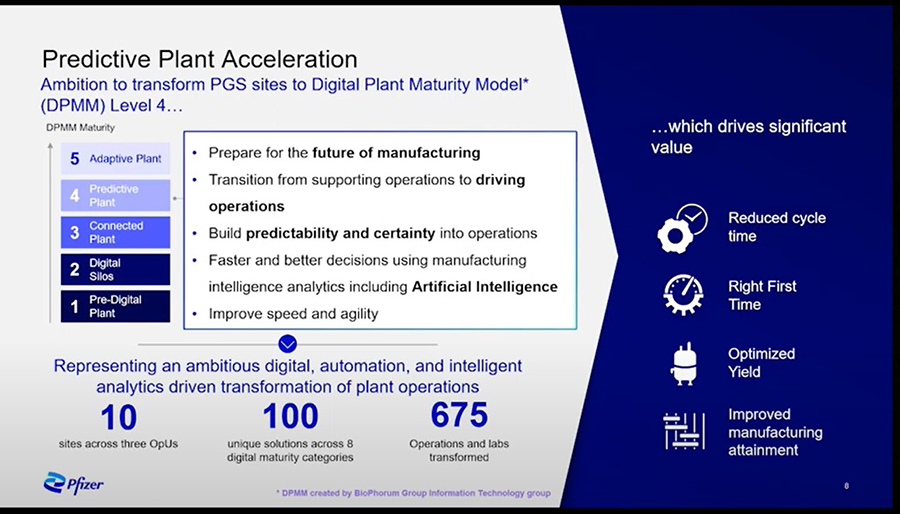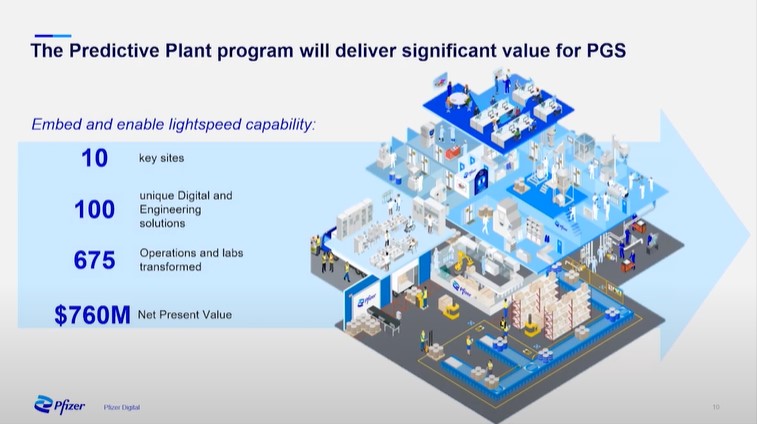- By Bill Lydon
- May 12, 2023
- Feature
Summary
Manufacturing management is increasingly recognizing the importance of manufacturing digitalization is a fundamental part of business strategy.

In a presentation at the 27th Annual ARC Industry Forum Mike Tomasco, vice president - Pfizer Digital Manufacturing, described the company’s six-year Digital Transformation journey, how it has grown and results achieved to date. He noted that Covid-19 created an urgency and need to implement digital transformation faster. “Everybody in manufacturing was asking, 'What do you have and when can we get it?' This helped us move faster," he siad. “It’s all about getting more data in context to do more things with analytics to improve operations driving the creation of more value.”
The digitalization team started in 2016 and has grown to include 240 people and 1,200 contractors. In 2022 there were 1,600 digitalization deployments impacting production of 100 products with plans to double the number deployments in the next year.

Blending IT and OT
Mike Tomasco, who leads the digital manufacturing group, said, “I’m an IT guy, and we are blending everything together as they converge. The digital manufacturing group brought together all the great things we were doing from a digital IT perspective, and then working with OT people throughout the company built the foundational OT digital systems across Pfizer which was a large task.”
Framing the scope of the challenge by the numbers, Pfizer has approximately 30,000 colleagues and contractors, 37 manufacturing sites, more than 300 contract manufacturers, produces 50 billion medicine doses annually, and supplies over 185 countries reaching 1.4 billion patients. “Every dose has to be perfect and high quality," Tomasco said. He explained his team’s major job is improving production and efficiency with high quality. “About a year and a half ago, the vice president of manufacturing noted, 'Everything you’ve been doing during the pandemic has been great; how can we do more; faster at more locations?'”
Pfizer has developed 100 digitalization core tested and proven capability modules that are building blocks for applications used to achieve the goal of installing solutions and operational quickly in production plants.
BioPhorm Digital Plant Maturity Model (DPMM)
Pfizer uses the BioPhorm Digital Plant Maturity Model (DPMM) he and others in the industry participated in creating that is openly available for anyone to download. An important part of the DPMM as a measurement tool to understand where your current operations measure up and identify areas for improvement applying digitalization. The model defines five automation levels:
- Level 1 - Predigital - Manual, Paper-Based Processes
- Level 2 - Digital Slices - Islands of Automation
- Level 3 - Connected Plant - High Level of Automation, Integration & Systems Standardization
- Level 4 - Predictive Plant - Integrated Plant Network, Pervasive Real-Time Predictive Analytics
- Level 5 - Adaptive Plant - Plant of the Future, Autonomous, Self-Optimizing, Plug-and-Play
In maturity Levels 1 and 2, the focus is on operations at individual plants. As maturity increases from Level 3 to Level 5, greater emphasis is placed on the plant as part of an integrated network of internal and external plants. This includes the end-to-end value chain that encompasses the patients who are the ultimate consumers and recipients of the medicines manufactured at the plants.

Focus on top 10
Pfizer started by focusing on the top 10 plants that generate the majority of products and revenue. Collaborating with corporate and plant engineering people they defined the existing systems and processes and set digitalization implementation goals. Teams created digitalization applications quickly and efficiently drawing on the 100 digitalization core capabilities rather than reinventing solutions unique to each site.
Collaboration mindset
Tomasco described changing the mindset to work with plants as a collaborative team rather than experts dropping in from corporate. A tracking methodology was created to determine after a digitalization solution goes live if it was effective in improving the operations. “The closed-loop method to measure that we are actually making a difference is important because every time you do that, you build better adoption.”
In the past, separate teams would work with plants independently implementing MES, data historian and manufacturing Intelligence, but now unified plans are developed.
User centric design
“We are keeping the user at the center, and I have a user experience design team that leads a lot of our efforts, think of a neutral third-party that doesn’t have extreme domain expertise, but they have the skill set to elicit things from people to share about how they feel when they are doing a process," Tomasco said.
They can translate those feelings into the design that people who understand math and translated into an interface that is easy understandable by users. “A couple years ago, I hired a person with this kind of background that made a real difference on our team helping us think differently about things and how we solve problems and how we interact with our partners on the plant floor and everyone else," Tomasco said. "We study how they work and make that into some type of interaction that makes sense for them not for us which has been a huge positive change."
Thoughts and observations
The technology and knowledge to apply digitalization has advanced significantly over the last few years. Attending the 2019 Pharmaceutical Automation Roundtable (PAR) the consensus was that the technology available at the time could be deployed to achieve Level 4 Predictive Plant. In the last four years, this has changed with the influx of commercial technologies that can be applied to achieve higher levels setting the stage for Level 5 Adaptive Plant applications discussed in the Biomanufacturing Technology Roadmap.
Manufacturing management is increasingly recognizing the importance of manufacturing digitalization is a fundamental part of business strategy. The requirement to do business differently during the pandemic in many ways has become a change agent shedding light on the value of manufacturing digitalization.
About The Author
Bill Lydon brings more than 10 years of writing and editing expertise to Automation.com, plus more than 25 years of experience designing and applying technology in the automation and controls industry. Lydon started his career as a designer of computer-based machine tool controls; in other positions, he applied programmable logic controllers (PLCs) and process control technology. Working at a large company, Lydon served a two-year stint as part of a five-person task group, that designed a new generation building automation system including controllers, networking, and supervisory & control software. He also designed software for chiller and boiler plant optimization. Bill was product manager for a multimillion-dollar controls and automation product line and later cofounder and president of an industrial control software company.
Did you enjoy this great article?
Check out our free e-newsletters to read more great articles..
Subscribe

